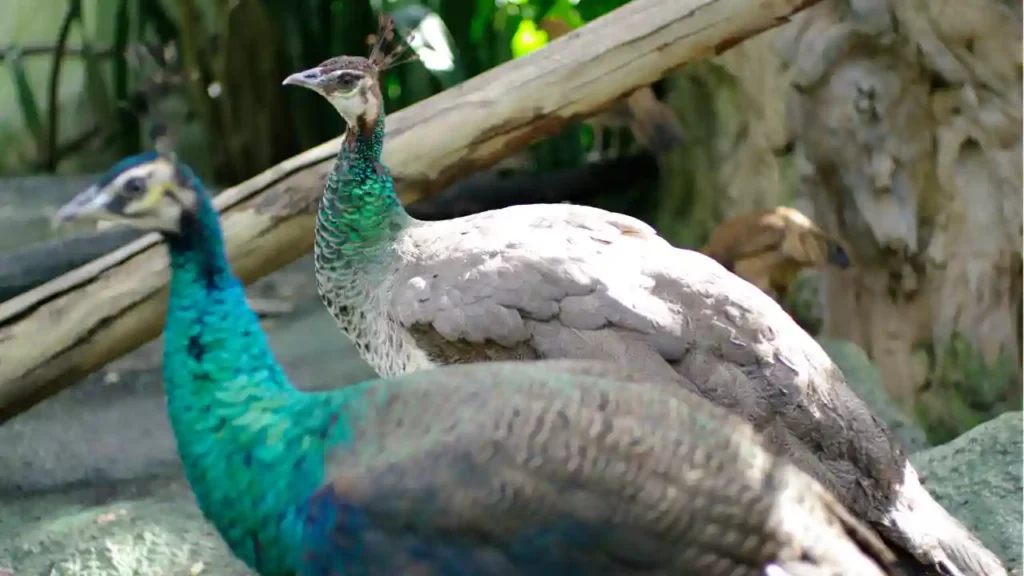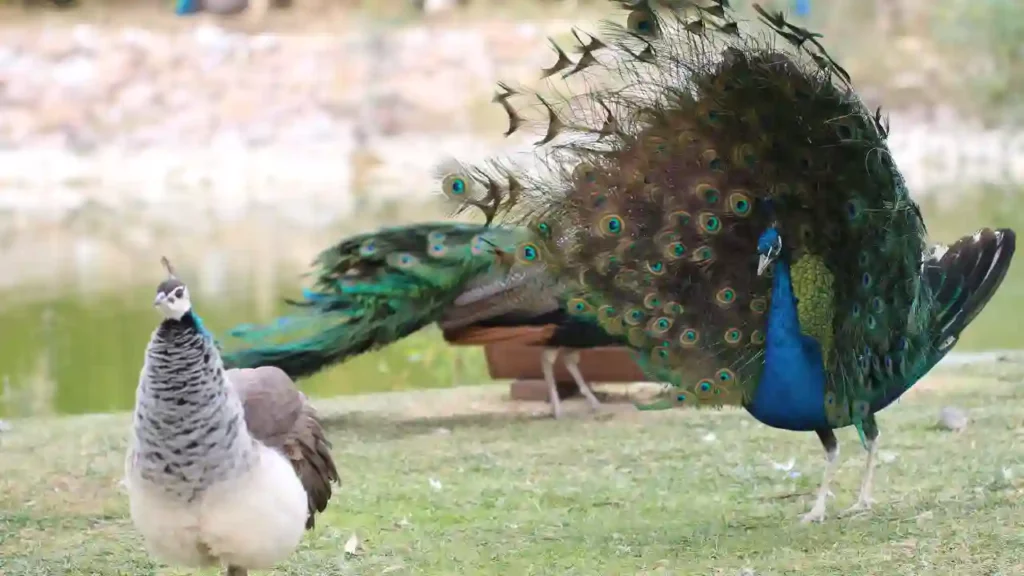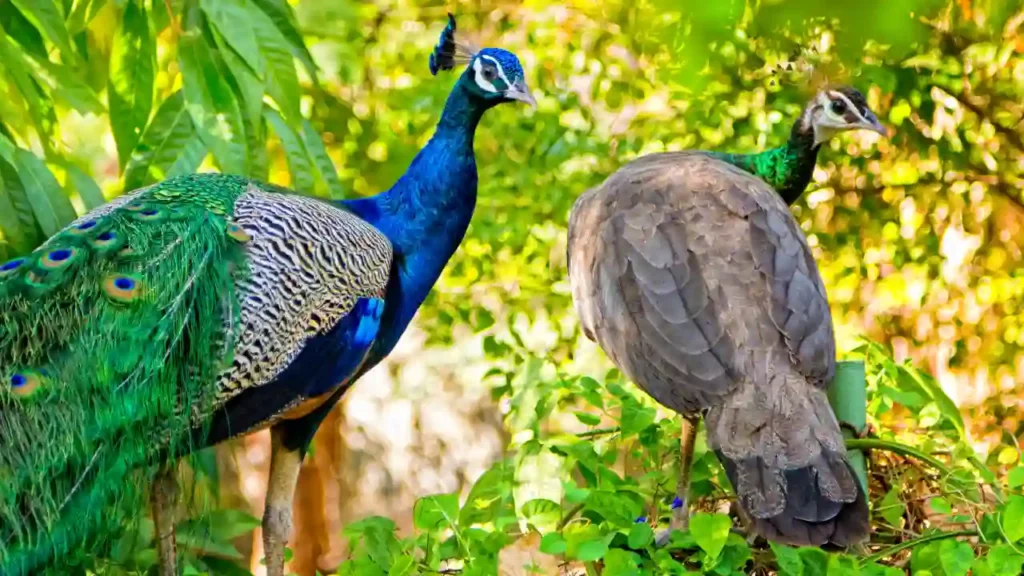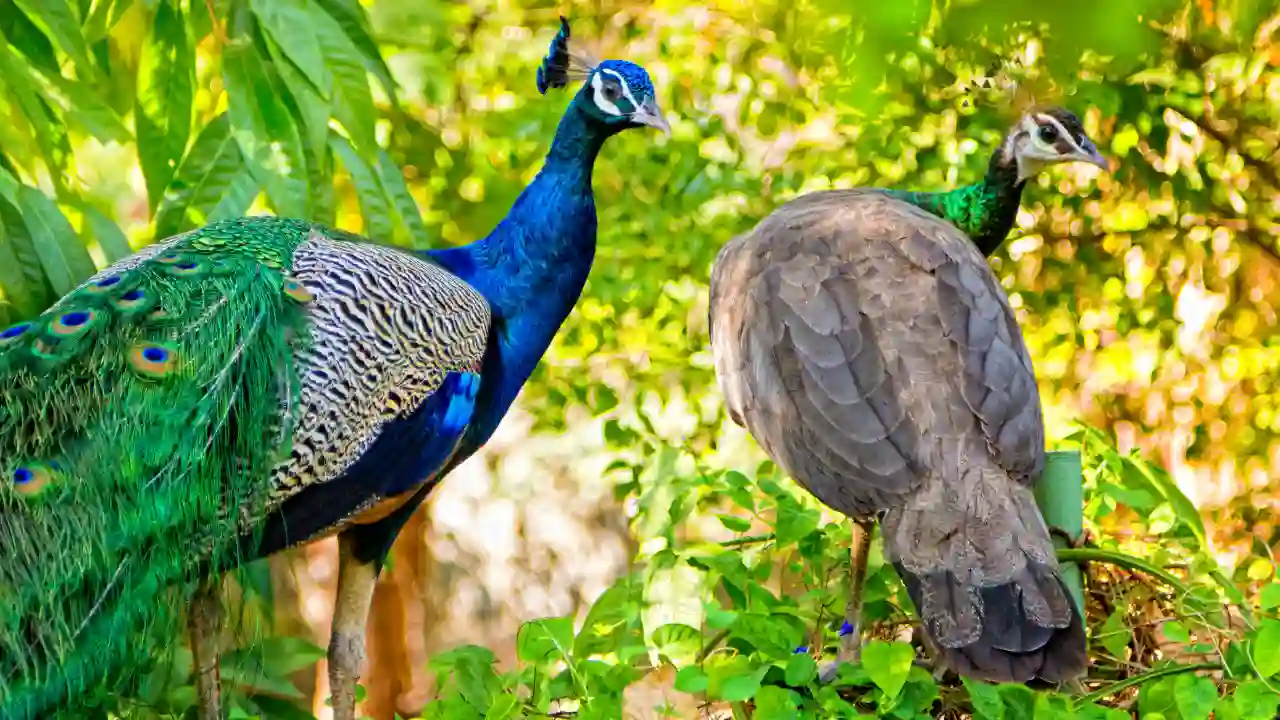Let’s start with a correction. There’s no such term as a female peacock. The exquisite bird with iridescent feathers of blue, green and white colors is called peafowl. Peacock is the male of the two genders of peafowls. A female peafowl is called a peahen.
The males and females of this species differ from one another in size, color, and behavioral characteristics. Peacock males differ from females in size, color, and unique mating behaviors which include wing-shaking and train-rattling.
We will learn more about the distinguishing features of a male peafowl and female peafowl in this article. So, let’s begin:
How Can You Tell If A Peacock Is Male Or Female?

The color of the peacocks’ feathers is one of the main identifying factors between male and female peacocks.
A male peacock’s feathers often have an opalescent tint of vivid blue. Male peacocks use their vivid blue hues to attract possible partners. On the other side, females often have delicate feather hues including tones of gray, cream, and even brown feathers.
The crests of female peacock feathers exhibit a subtly neutral hue, ranging from shades of brown to creamy tones.
Another significant point is that females have white stomachs, whilst males have bellies that are blue in hues like their plumage. The faint tint of the females’ feathers provides them the advantage when it comes to hiding or escaping predators, despite the fact that males are noticeably more beautiful.
If you are interested in learning the distinction between male and female peafowls , you should also know about the covert feathers that are found on male peacocks’ backs. These feathers are in huge numbers and their main function is to conceal the base of the tail feathers.
Also, it is likely that male peacocks have such feathers on their backs that resemble scales just next to their covert feathers.
In contrast to the brown or solid-colored feathers on their rear, the female peacock’s throat has scale-like plumes. These feathers are fanned by male peacocks to entice a prospective partner during courting.
Peacocks do not only have feathers; they also have prominent white patterns around their eyes.
In contrast to the female peacock, which tends to have its white marks merge in with its plumes and skin color, the male peacock has more noticeable white streaks along each of its eyes.
What Is A Peacock Female Called?
The female peafowl, which weighs an average of four kilos, is referred to as a peahen. Peahens are less colorful, having a basic brown hue and less train.
The male bird is called the peacock, is well recognised for its attractiveness and antics.
It is the larger of the two, with various studies finding that it weighs an average of seven kilos when adequately fed and housed in a suitable habitat. The peacock possesses a train of tail feathers.
Are Female Peacocks Bigger Than Males?

The size of male and female peafowls is very distinct and one can tell between a male and female peafowl just by looking at them.
Peahens, or female peacocks (let’s just say that for the purpose of this article), are much lesser in size than male peacocks.
Peacock males may grow to be 3 to 4 feet long and up to 13 pounds in weight. Usually, female peacocks are 2 to 3 feet long and up to 9 pounds in weight.
Although both male and female have spurs, men often grow spurs earlier than females do. Males also typically have longer legs than females.
Female spurs are also smaller and more bluntly shaped.
There is another notable gender difference observed in Indian peafowl, and that is their size.
The males, with an impressive length ranging from 3 to 4 1/2 feet and weighing between 9 and 13 pounds, are noticeably larger than their female counterparts.
On the other hand, the peahens measure between 2 1/2 and 3 1/2 feet in length and weigh between 6 and 9 pounds.
Behavior Differences (Male Vs Female Peacocks)

Although both male and female peacocks dwell in flocks in the natural environment, one of the key behavioral distinctions between the two is that male peacocks are more isolated.
You can distinguish between male and female peafowl by observing their behavior. Males engage in behaviors like train-rattling and feather fluttering that females do not.
When it comes to comparing mating behavior, females might become violent and compete with one another for the finest male candidates.
Only female peafowl construct nests and care for the eggs; males take absolutely no parenting role whatsoever.
Both men and females can survive alone or in small numbers in the wilderness, although males are more inclined to do so.
Sexual Selection And Courtship
During mating season, male and female peacocks exhibit further distinct behavioral distinctions. Male peacocks attract ladies’ attention by rattling their tails and flapping their wings.
Males occasionally expose their semi-circular tails while standing close to plants so that ladies may see them from a great distance.
Females are more violent than males during mating and breeding season itself, and they frequently engage in physical conflict with one another for the best available guy as a possible partner.
Raising Young
Female peacocks are responsible for building nests for babies and incubating eggs, males often show minimal parental participation.
Similar to how male peacocks do while courtship, female peacocks exhibit their tail feathers in moments of exhilaration or threat.
The peacocks flaunt their extremely gorgeous feathers to win over possible mates.
In order to warn other females that their chicks are at risk or to compete for a potential mate, peahens regularly flaunt their feathers.
Calls And Vocalizations
When both peacocks and peahens interact or convey their expressions, the noises they make are noticeably different. The peacock calls louder than the peahen.
The peacock must call louder in order to attract the attention of the female peafowls, who have the last say and decide which peacock they will pair with.
This describes why peacocks generate louder cries than their female counterparts, particularly when breeding or feeding their offspring.
Can Female Peacocks Raise Young Alone?

The peahen rears the chicks by herself and the male peacocks do not get involved in raising the young alone.
Three to eight brown or light green eggs are laid in the nest she makes. She perches on the eggs virtually continually during the 28-to-30-day incubation period.
The peachicks can move and forage independently as soon as they are hatched. Only two out of every six peachicks survive to adulthood due to their extreme vulnerability and high rate of mortality.
They may fly up into a tree for protection after two weeks of being born.
The babies develop crests at four weeks, and at two months they resemble their mothers but are only half as big.
In their second year of life, males do not develop their mature coloration.
Are Female Peacocks Colorful?
One notable difference between male and female peacocks is the presence of unique colors throughout the already impressive tail feathers.
Peacocks are colorful and appealing because they must attract females for coupling, which is only possible if one is dazzling enough to entice a potential mate.
Females, on the contrary hand, are bland and less beautiful since they do not need to entice men for breeding but have the ultimate say when it comes to choosing their mating partners.
Do Female Peacocks Spread Their Feathers?
During courting, male peacocks spread their feathers and keep their tails upright in a fan-like display. They display the most alluring tail feathers in order to win over the female peacock.
While female peacocks, also known as peahens, do spread their tail feathers, the gesture is very different from the spectacle made by a male peacock while fanning his tail feathers.
In contrast to peacocks, peahens lack the huge, colorful tail feathers and distinguishing eye pattern. Their tail feathers are blander, shorter, and brownish.
When frightened or in danger, female peacocks often spread and shake their tail feathers. They do this to give off the impression that they are bigger and more threatening.
Can A Female Peacock Fly?
Yes, female peacocks can fly (Check our guide on peacocks flying abilities). They often do this to forage at night and to flee from predators.
As we discussed that peahens do not possess the massive train of feathers that peacocks have and that they are comparatively smaller in size, they are actually better at flying than their male counterparts.
But, that said, they still can’t fly that far when compared to other birds of the pheasant family.
Final Thoughts
The visual characteristics of male and female peacocks differ significantly. Even if you are unfamiliar with peafowl, it is simple to distinguish between male and female peacocks. The tail feathers of male peacocks are exceptionally lovely. Then, a decorative ocellus, sometimes known as an eye-spot, is present on each of the long tail feathers. Females, in contrast, lack it. Since they lack any long feathers at all, female peacocks are unable to expand their feathers.


